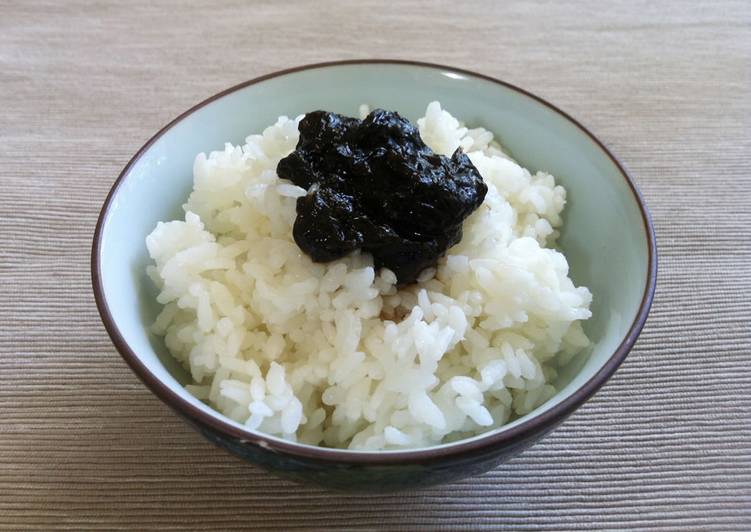Nori 'Tsukudani'. Read Customer Reviews & Find Best Sellers. Its name originates from Tsukuda-jima, an island in Tokyo where it was first made in the Edo period. Tsukudani is usually seafood or seaweed strongly flavored with Soy Sauce.
 In Japan, the most commonly known Nori Tsukudani is in jars you can buy at.
Seaweed 'Tsukudani' are often made with Kombu (Kelp) OR Nori.
But for me, Wakame 'Tsukudani' is the easiest to make.
The end of the day exhaustion often boost you over the edge and into a drive-thru window. But indeed, there are some really quick and easy recipes here to help you get a yummy and ideal meal on the table in no time.
In Japan, the most commonly known Nori Tsukudani is in jars you can buy at.
Seaweed 'Tsukudani' are often made with Kombu (Kelp) OR Nori.
But for me, Wakame 'Tsukudani' is the easiest to make.
The end of the day exhaustion often boost you over the edge and into a drive-thru window. But indeed, there are some really quick and easy recipes here to help you get a yummy and ideal meal on the table in no time.
You can have Nori 'Tsukudani' using 5 ingredients or wanting. Here is how you cook it.
The main ingredient Nori 'Tsukudani'
- Provide of Nori Sheets *tear into small pieces.
- You need of Dashi Stock.
- Prepare of Sugar.
- You need of Soy Sauce.
- You need of Mirin or Sake.
Contents: Nijiya's Nori Tsukudani Nori Tsukudani Recipe Nijiya's Nori Tsukudani New items added to our popular "Nijiya Small Bottle" series are Nori Tsukudani and Nori Tsukudani with Shiitake. Nori tsukudani is made with simple ingredients-nori seaweed and seasonings; Nori Tsukudani with Shiitake has added shiitake mushrooms. Nori seaweed is rich in protein, vitamins, and minerals. Tsukudani comes in many varieties, but even among those "Nori no Tsukudani (海苔の佃煮)" is most commonly eaten in Japan. "Nori (海苔)" is a seaweed known as laver in English, so Nori no Tsukudani is a pasty food produced by boiling down Nori seaweed typically with soy sauce and sugar.
These recipes cook in about 20 minutes from begin to finish, and 1 paces. Get ready to follow these recipes to get you by means of a strenuous back-to-school monsoon!. Here is how you make 1 pacesthat.
Nori 'Tsukudani' guide
- Place all ingredients in a small saucepan. Carefully bring to a boil, then reduce to simmer until jelly-like texture is achieved. Serve with freshly cooked fluffy hot rice..
Tsukudani (佃煮) is small seafood, meat or seaweed that has been simmered in soy sauce and mirin. High osmotic pressure preserves the ingredients. [further explanation needed] Its name originates from Tsukudajima, the island (in present-day Chūō, Tokyo) where it was first made in the Edo period. Many kinds of tsukudani are sold. Traditionally made tsukudani is preservable and has been. Tear Nori sheets into pieces and place them in a pot.
Cooking is activity are often run by everyone, but not everyone has expertise in making the maximum Nori 'Tsukudani', what are they?
Tips make Nori 'Tsukudani' to get results that are maximum
- Filtering the right food ingredients also affect the results of cooking, starting from selection fresh ingredients will be very good because the reserves of the nutrition is still very good.
- Equipment The cookware used must also match what is cooked. Also, care must be taken that the cleanliness of the cookware does not affect the taste and nutritional content.
- How to make Nori 'Tsukudani', which includes which ingredients must be processed first and which ones are processed later and when to add spices. This is done in order to produce cuisine which has nutritional quality and cooked food maturity without reducing the delicacy of the cuisine.
Create all people, cooking is indeed something which is quite soft. Besides they are indeed like cooking and have will cooking that is quite, they are also creative in processing each dish so that it becomes dish luscious. But there are those who cannot cook, so they must ask and see recipes that are cushy to follow.
Already know the things you need to consider when cooking Nori 'Tsukudani'? Try to use and choose the right food ingredients and follow the steps in cooking properly. good luck...!!!
Tsukudani (佃煮) is small seafood, meat or seaweed that has been simmered in soy sauce and mirin. High osmotic pressure preserves the ingredients. [further explanation needed] Its name originates from Tsukudajima, the island (in present-day Chūō, Tokyo) where it was first made in the Edo period. Many kinds of tsukudani are sold. Traditionally made tsukudani is preservable and has been. Tear Nori sheets into pieces and place them in a pot.